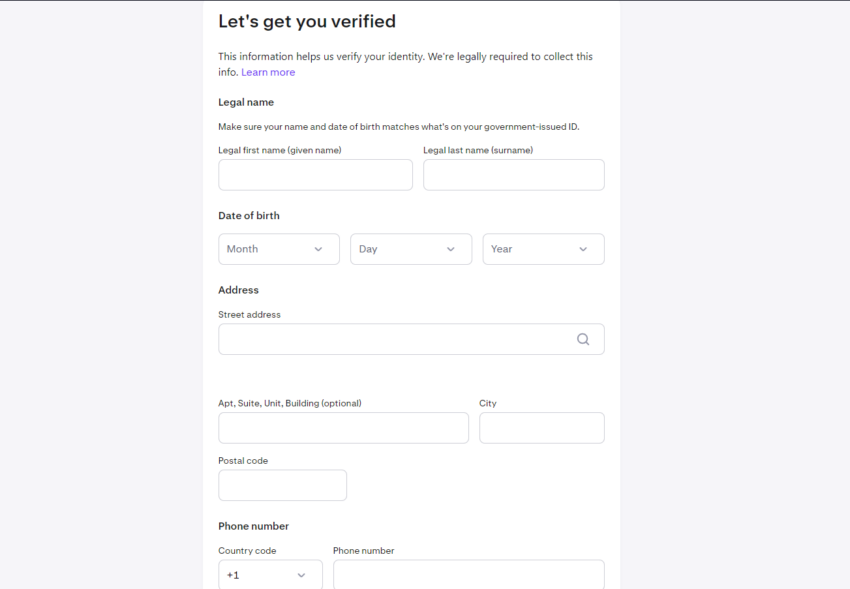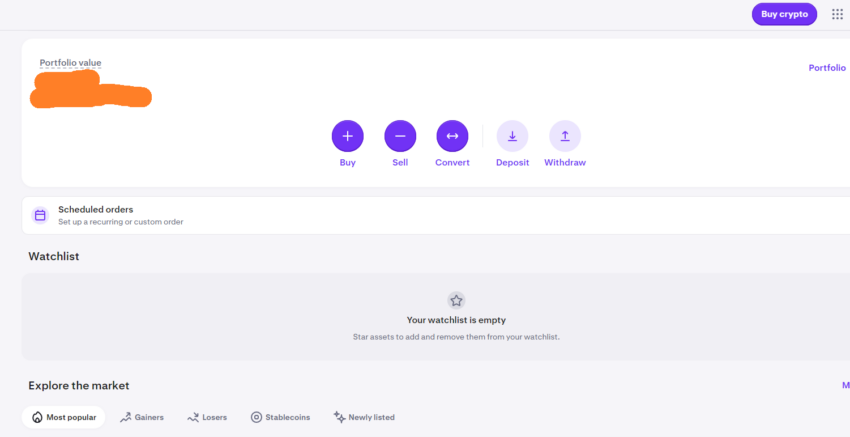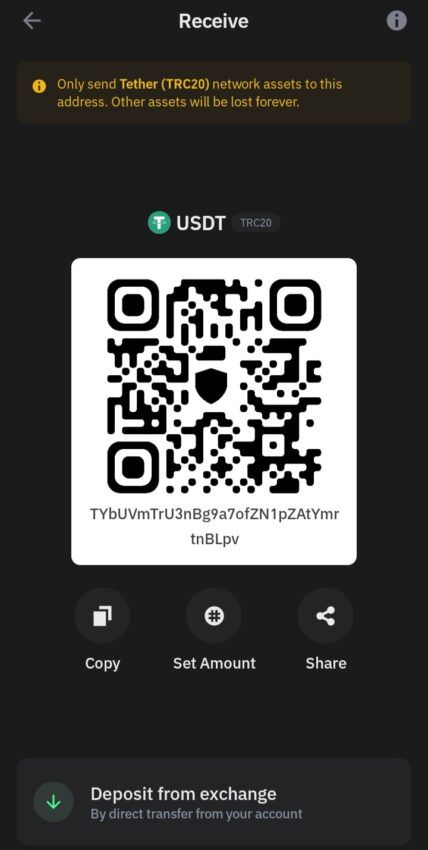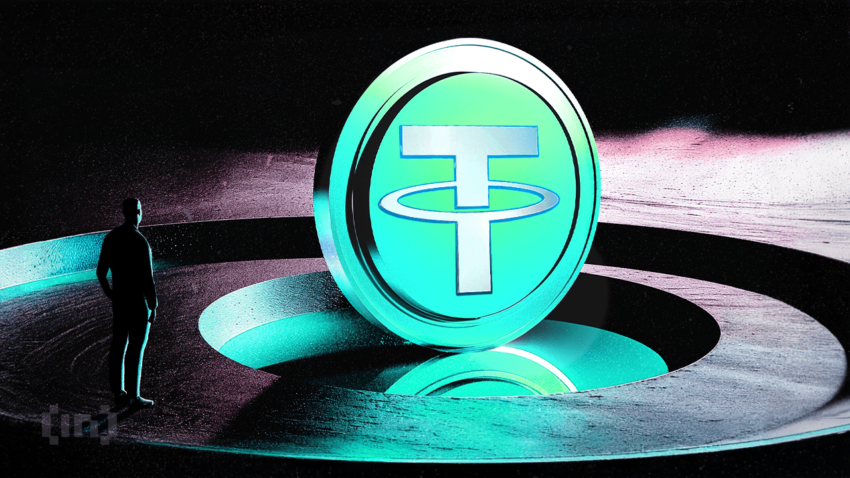Tether (USDT) is arguably the most popular stablecoin in the market in 2025. Originally built on the Omni protocol, this dollar-pegged crypto has since expanded to multiple blockchains like Ethereum, TRON, and EOS. This guide explores the different versions of Tether, how to buy and store it, and what you need to know before using it.
KEY TAKEAWAYS
➤ Tether (USDT) is a stablecoin pegged to the U.S. Dollar. It’s value is typically always close to $1 regardless of market volatility.
➤ Tether operates on Omni, Ethereum (ERC20), TRON (TRC20), and EOS blockchains.
➤ You can identify the Tether type by checking the wallet address format. For example, ERC20 addresses start with 0x.
How to buy and store Tether (USDT)
Before we get into the step-by-step procedure, here’s a quick overview of how to buy USDT:
1. Choose a reliable exchange like Binance, Coinbase, or Kraken to get started.
2. Sign up, verify your identity, and complete the KYC process.
3. Deposit funds using a bank transfer, card, or cryptocurrency.
4. Search for USDT, and choose the variant (Omni, ERC20, TRC20) before placing a buy order.
5. Transfer your USDT to a compatible wallet for secure storage.
Now, let’s walk you through the step-by-step procedure for buying USDT using Kraken as an example. Note that the procedure will be similar regardless of which platform you choose, albeit with some minor differences here and there.
1. Create an account on Kraken
Visit the Kraken website and sign up by entering your email and creating a password. Complete the account setup by verifying your email.

2. Complete identity verification
After logging in, navigate to the verification section and upload the required documents for KYC, such as a photo ID and proof of address. This step is necessary to deposit funds and start trading.

3. Deposit funds into your Kraken account
Once verified, go to the “Deposit” tab and choose your preferred deposit method. Follow the instructions to complete your deposit.

4. Search for USDT and choose a variant
In the “Buy” section, search for USDT. If the exchange you are using lists different USDT variants, you will have to choose the correct one before proceeding. Enter the amount of USDT you wish to buy. You can choose between a market order to buy at the current price or a limit order to set your preferred price. Confirm the order to complete your purchase.

6. Transfer USDT to a secure wallet
After buying, transfer your USDT to a compatible external wallet for safekeeping. Depending on the variant (ERC20, TRC20), select a wallet that supports the corresponding blockchain, such as Trust Wallet.

What is Tether?
Disclaimer: The information provided in this article is for informational purposes only and should not be considered financial, investment, or trading advice. It does not constitute an endorsement of any specific product, service, or financial instrument. Always conduct your own research and consult with a qualified financial advisor before making any financial decisions.
Tether (USDT) is a stablecoin designed to maintain a 1:1 peg with the U.S. Dollar. It provides stability in the volatile cryptocurrency market by keeping its value close to $1. Tether operates across multiple blockchains, which makes it widely available for trading and transactions.
Tether was developed under the Omni protocol, a system that sits on top of the Bitcoin network. Omni can make unique tokens, akin to what is possible on other networks using smart contracts. The Omni protocol gave birth to the first Tether.
In time, developers began migrating the asset to other blockchains. This is because platforms that natively support smart contracts make more sense for a stablecoin. The first move was to the Ethereum network, which is the most popular smart contract platform today. TRON and EOS have also seen their own variations of the asset.
Different types of Tether

Omni Tether
Omni Tether was the original version of Tether, launched in 2014 using the Omni protocol, which runs on the Bitcoin blockchain. Although it was groundbreaking at the time, Omni Tether’s reliance on Bitcoin led to slower transaction speeds and higher fees, causing its popularity to decline.
Nevertheless, it is still supported by a few exchanges and can be stored in wallets like Omniwallet, which also supports Bitcoin transactions.
ERC20 Tether
In 2017, Tether migrated to the Ethereum blockchain with the launch of ERC20 Tether. This version of Tether is now the most commonly used, thanks to Ethereum’s faster transaction speeds and widespread adoption.
ERC20 Tether can be used with any Ethereum-compatible wallet, and due to Ethereum’s smart contract ecosystem, it is the preferred version for those developing DeFi applications.
However, as of September 2024, high gas fees could be a concern if you frequently use ERC20 USDT.
TRC20 Tether
RON’s focus on speed and cost-efficiency has made TRC20 Tether an increasingly popular option, particularly for users looking to avoid Ethereum’s rising transaction fees.
TRC20 Tether boasts zero-fee transfers and almost instantaneous transactions, making it a highly attractive option for frequent traders and those in need of fast liquidity.
EOS Tether
Announced in May 2019, EOS Tether is the latest and smallest-volume version of Tether. Like its Ethereum and TRON counterparts, the EOSIO network also seeks to remove transaction fees and enable block producers to focus more on transaction processing.
Tether variants compared
| Attribute | Omni Tether (Bitcoin) | ERC20 Tether (Ethereum) | TRC20 Tether (TRON) | EOS Tether (EOS) |
|---|---|---|---|---|
| Blockchain | Bitcoin (Omni Protocol) | Ethereum | TRON | EOSIO |
| Transaction speed | Slow (10 minutes per block) | Varies (15 seconds to several minutes) | Very fast (3 seconds per block) | Very fast (0.5 seconds per block) |
| Transaction fees | High (Bitcoin network fees) | Medium (Ethereum gas fees) | Low (almost zero) | Zero fees |
| Wallet address format | Starts with 1, 3, or bc1 | Starts with 0x | Starts with T | EOS account format |
| Primary use cases | Older Tether version, niche use | DeFi, trading, most exchanges | Fast, low-cost transfers, trading | Fee-free transactions |
| Best wallet options | Omniwallet | MetaMask, MyEtherWallet, Ledger | TronWallet, Ledger | EOS-compatible wallets |
A word of caution
If you are just using Tether to trade on an exchange as a substitute for the US Dollar, then it doesn’t matter which form of USDT you use; they will all basically work equally.
One caveat to this is that there could be liquidity issues if you are dealing with one of the less popular versions. However, this shouldn’t be a problem with any of the big-name exchanges.
On the other hand, if you already have some Tether on an exchange or in a wallet and would like to move it, then this becomes a very important issue. Admittedly, this makes Tether more confusing to use.
If you send Tether to an incompatible wallet, you will lose it. Therefore, it is essential that you are confident of what you are sending and where you are sending it.
Tether in any form is just a token on a network. The token is just the underlying asset packaged to act in a certain way. Hence, Omni Tether is just packaged Bitcoin, ERC20 Tether is just Ethereum, and so on. Since these blockchains are not compatible, neither are their versions of Tether.
How to identify Tether variants?
Sometimes, the asset is marked, especially if an exchange uses multiple types. Unfortunately, most exchanges use just one type, often just labeled as “USDT.” There can be a few ways to figure out which is running under the hood.
First, you could search the site for any documentation or press releases about USDT. Sometimes, there is info in the FAQs or Help section that explains which Tether to buy or store. Other times, you can find an announcement that the exchange has switched to one version exclusively.
If none of this pans out, you could try reaching out to the exchange’s support team. Of course, some teams are more responsive than others, and depending on the service, it could take a bit of time to get a response.
If you want to be certain about which type you are using, look at the address associated with the wallet. Remember, all forms of Tether are just tokens on the underlying blockchains, so the addresses are always valid for those blockchains.
For the time being, don’t worry about EOS Tether, as it is almost certainly not the type your exchange is using unless clearly marked.
Omni Tether will look just like a Bitcoin address, for example:
1EKrH8VvrXEz5jEUbHBGeQdvwhBY73UaNe
It is important to note that Bitcoin addresses always begin with a 1, 3 or bc1 at the beginning. This is in contrast with Ethereum addresses, which begin as follows:
0x643B079a9706d62F56CC1c9904F0E7ffE3111236
The key thing to recognize is that an Ethereum address always begins with 0x. In a similar vein, we have TRON addresses, which have the distinct feature of always beginning with a capital T:
TAVXrv4yVyzMq6VqTYgmd8e1zazJ2r2Pkp
At a glance, these are all just random digits; even so, all are distinguishable by how they begin. Each one begins in a certain way. If you are sending to a wallet address that begins with 0x, it is an Ethereum address.
Now that we’ve covered all of let’s talk about where to get and how to keep each of the three main flavors of Tether.
Where to buy and store different Tether variants?
Omni Tether
Though less common in 2025, Omni Tether is still available on platforms like StormGain. Given the declining popularity of Omni Tether, liquidity may be limited on exchanges, and users are encouraged to store Omni Tether in secure wallets like Omniwallet.
This web wallet can act as a Bitcoin wallet, Omni Tether wallet, or any other Omni-based token. Two great features of this wallet are a web interface and the ability to retain control of your private keys. Additionally, you can actually use the wallet as a Bitcoin/Omni token exchange. This means you can buy and sell your Bitcoin for Omni Tether, and vice versa, at any time.
ERC20 Tether
ERC20 Tether remains the most widely available version and is supported by most major exchanges including Binance, Coinbase, Kraken, and Bittrex.
Once purchased, ERC20 Tether can be stored in any Ethereum-compatible wallet, such as MetaMask or MyEtherWallet. For added security, consider using a hardware wallet like Ledger Nano X or Ledger Nano S.
TRC20 Tether
TRC20 Tether has seen increasing adoption due to its zero fees and fast transaction times. It is supported by exchanges like Bitfinex and Poloniex. Users who prefer to store TRC20 Tether off-exchange can do so in TRON-compatible wallets such as TronWallet or the popular hardware wallets mentioned above, provided they support TRON assets.
If you want to take your TRC20 Tether off of an exchange, find a TRON wallet that supports TRC20 tokens. Popular options include Trust Wallet and TronWallet.
Is Tether a good investment in 2025?
In 2025, Tether remains a stable store of value in the highly volatile crypto market. That said, it is not designed for price appreciation. Investors should view Tether primarily as a tool for maintaining liquidity and minimizing risk during trading.
While Tether offers the stability of being pegged to the U.S. Dollar, its centralized nature and past controversies regarding reserves have sparked debates about its long-term viability. Users should weigh these $pros and cons and stay informed about developments surrounding its regulatory and legal standing.
Frequently asked questions
What is a Tether stablecoin?
Where can I buy Tether?
How do I know which Tether I am using?
Disclaimer
In line with the Trust Project guidelines, the educational content on this website is offered in good faith and for general information purposes only. BeInCrypto prioritizes providing high-quality information, taking the time to research and create informative content for readers. While partners may reward the company with commissions for placements in articles, these commissions do not influence the unbiased, honest, and helpful content creation process. Any action taken by the reader based on this information is strictly at their own risk. Please note that our Terms and Conditions, Privacy Policy, and Disclaimers have been updated.




